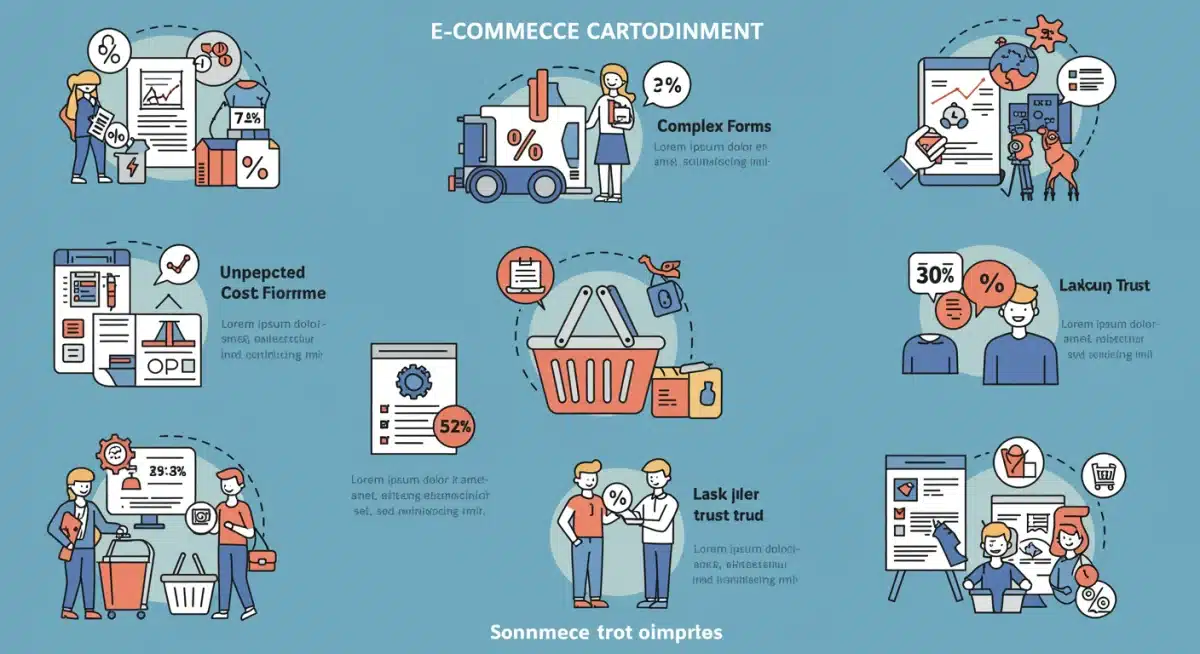Building a High-Converting E-commerce Checkout Flow in 2025: Reduce Cart Abandonment by 18%

Building a high-converting e-commerce checkout flow in 2025 is paramount for online businesses seeking to reduce cart abandonment by 18% through strategic design and technological advancements.
As the digital retail landscape evolves at an unprecedented pace, the imperative for online businesses to optimize their core operations intensifies. The focus is squarely on Building a High-Converting E-commerce Checkout Flow in 2025: Reduce Cart Abandonment by 18%, a critical goal for sustained growth. This report delves into the latest strategies and technological shifts poised to reshape how consumers complete online purchases, directly addressing the challenge of abandoned carts.
The Current State of E-commerce Checkout and Abandonment
Recent data indicates that cart abandonment remains a significant hurdle for e-commerce, with rates often hovering between 70% and 80%. As of late 2024, businesses are aggressively seeking solutions to mitigate these losses. The primary drivers for abandonment frequently include unexpected shipping costs, forced account creation, complex checkout processes, and concerns over security.
Understanding these pain points is the first step toward effective optimization. In 2025, consumer expectations for a seamless, intuitive, and secure purchasing journey will be higher than ever. Retailers failing to adapt risk falling behind competitors who prioritize a frictionless checkout experience, directly impacting their bottom line and market share.
Key Factors Driving Cart Abandonment Today
- Unexpected Costs: Hidden fees, high shipping costs, and taxes revealed late in the process often surprise customers.
- Forced Account Creation: Many users prefer to checkout as guests, viewing mandatory registration as an unnecessary barrier.
- Complex Forms: Lengthy forms requiring excessive personal information can deter purchasers.
- Security Concerns: Doubts about payment security or data privacy can lead to immediate abandonment.
Streamlining the Checkout Process: A 2025 Imperative
The push to streamline the e-commerce checkout process is becoming a central theme for 2025. This involves reducing the number of steps, minimizing required information, and ensuring every interaction is purposeful. The goal is to guide the customer swiftly and confidently from product selection to purchase confirmation, removing any potential friction points that could lead to hesitation or abandonment.
Successful streamlining efforts are projected to significantly contribute to the 18% reduction target in cart abandonment. This isn’t merely about aesthetics; it’s about intelligent design that anticipates user needs and removes obstacles. Retailers are actively investing in UX research to identify and eliminate bottlenecks within their current checkout flows, preparing for the demands of the coming year.
Best Practices for a Simplified Flow
- Guest Checkout Options: Always provide the option to checkout without creating an account.
- Progress Indicators: Clearly show customers how many steps are left in the process.
- Autofill Functionality: Implement autofill for addresses and payment details to save time.
- Minimal Information Fields: Only ask for essential information required to complete the transaction.
The Role of Personalized Experiences in Conversion
Personalization is no longer an optional extra; it’s a fundamental component of a high-converting e-commerce checkout flow. In 2025, leveraging AI and machine learning to tailor the checkout experience will be crucial. This can range from pre-filling known customer details to offering relevant upsells or cross-sells based on purchase history or browsing behavior, all within the checkout environment.
A personalized approach fosters a sense of recognition and value, making the customer feel understood and appreciated. This emotional connection can significantly enhance trust and reduce the likelihood of abandonment. Furthermore, dynamic pricing or personalized shipping options presented at checkout, based on loyalty or location, can provide that extra nudge towards conversion.
Advanced Payment Solutions and Security Protocols
The landscape of payment solutions is rapidly evolving, with new methods emerging to offer greater convenience and security. For 2025, integrating a diverse range of payment options, including digital wallets, buy now, pay later (BNPL) services, and even cryptocurrency, will be vital for a high-converting checkout. Crucially, these options must be presented in a way that instills complete confidence in the customer regarding the security of their financial data.
Robust security protocols, such as multi-factor authentication, advanced encryption, and visible trust badges, are non-negotiable. Consumers are increasingly aware of cybersecurity risks, and any perceived vulnerability in the checkout process can lead to immediate abandonment. Retailers must proactively communicate their security measures to build and maintain trust, ensuring a secure transaction environment that supports the goal of reducing cart abandonment by 18%.
Emerging Payment Technologies
- Digital Wallets: Integration with Apple Pay, Google Pay, and Samsung Pay for one-tap payments.
- Buy Now, Pay Later (BNPL): Offering flexible payment installments through providers like Affirm or Klarna.
- Cryptocurrency Payments: Exploring options for popular cryptocurrencies as a payment method for early adopters.
Mobile Optimization and One-Click Checkout
With mobile commerce continuing its exponential growth, optimizing the checkout flow for mobile devices is paramount. A truly high-converting e-commerce checkout in 2025 must offer a seamless, responsive experience across all screen sizes. This extends beyond just visual adaptation to include features like one-click checkout, which dramatically reduces friction for returning customers.
One-click checkout, enabled by securely stored customer and payment information, allows users to complete a purchase with a single tap or click. This feature, while requiring careful implementation of security measures, is a powerful tool for boosting conversion rates, particularly on mobile where typing extensive details can be cumbersome. The emphasis is on speed and convenience, directly addressing common mobile checkout frustrations.

Leveraging Data Analytics and A/B Testing
In the quest to achieve an 18% reduction in cart abandonment, data analytics and A/B testing will serve as indispensable tools for continuous optimization. By meticulously tracking user behavior throughout the checkout process, businesses can identify specific points of friction, drop-off rates, and areas ripe for improvement. This data-driven approach moves beyond guesswork, providing concrete insights into what works and what doesn’t.
A/B testing, in particular, allows retailers to experiment with different checkout layouts, button placements, form fields, and messaging, measuring the direct impact of each change on conversion rates. This iterative process of testing, analyzing, and refining ensures that the checkout flow is constantly evolving towards peak efficiency and user satisfaction, directly supporting the goal of a high-converting e-commerce checkout flow in 2025.
Data-Driven Optimization Strategies
- Heatmap Analysis: Visualize user interaction to understand where attention is focused or lost.
- Funnel Analysis: Track conversion rates at each step of the checkout process to pinpoint drop-off points.
- User Session Replays: Watch anonymized recordings of user sessions to identify frustrating experiences.
- A/B Testing Elements: Test variations of calls-to-action, form layouts, and payment options.
Post-Purchase Engagement and Recovery Strategies
While the primary focus is on preventing abandonment, a comprehensive strategy for building a high-converting e-commerce checkout flow in 2025 also includes robust post-purchase engagement and cart recovery mechanisms. For instances where abandonment still occurs, intelligently designed recovery campaigns can bring a significant percentage of those customers back to complete their purchases.
This often involves personalized email or SMS reminders, sometimes coupled with incentives like discounts or free shipping, sent shortly after abandonment. Furthermore, post-purchase communication, such as order confirmations, shipping updates, and feedback requests, solidifies customer trust and encourages repeat business, contributing to the overall lifetime value and reinforcing the positive checkout experience.
| Key Point | Brief Description |
|---|---|
| Reduce Cart Abandonment | Targeting an 18% reduction through optimized checkout processes and user experience enhancements. |
| Streamlined Checkout | Simplifying steps, offering guest checkout, and minimizing form fields for faster transactions. |
| Advanced Payments | Integrating diverse options like digital wallets, BNPL, and robust security for customer confidence. |
| Mobile Optimization | Ensuring responsive design and one-click checkout for seamless mobile purchasing experiences. |
Frequently Asked Questions About E-commerce Checkout Optimization
Reducing cart abandonment by 18% directly translates to significant revenue recovery for e-commerce businesses. It reflects a tangible improvement in the customer journey, indicating that optimization efforts are effectively converting browsing interest into completed sales, boosting profitability and market competitiveness in 2025.
Primary factors include unexpected costs like high shipping fees, forced account creation, overly complex or lengthy checkout forms, and unresolved security concerns regarding payment information. Addressing these friction points is crucial for improving conversion rates and user trust.
Personalization, driven by AI, enhances the checkout experience by pre-filling known customer details, offering relevant product recommendations, or tailoring shipping and payment options. This creates a more efficient and valued experience, making customers feel understood and reducing their likelihood of abandoning their purchase.
Advanced payment solutions, such as digital wallets and BNPL services, offer flexibility and convenience, catering to diverse customer preferences. Integrating these options, alongside robust security protocols, builds trust and removes payment-related barriers, directly contributing to higher conversion rates and fewer abandoned carts.
Mobile optimization is critical because a significant portion of e-commerce traffic originates from mobile devices. A seamless, responsive mobile checkout, often featuring one-click purchasing, minimizes user effort and frustration on smaller screens, drastically improving completion rates and overall customer satisfaction.
What Happens Next
The push for a high-converting e-commerce checkout flow in 2025 is not a fleeting trend but a fundamental shift in online retail strategy. As businesses continue to refine their digital storefronts, expect to see accelerated adoption of AI-powered personalization, broader integration of diverse payment methods, and an unwavering focus on mobile-first design. The 18% reduction target in cart abandonment serves as a clear benchmark for success, driving innovation and competitive advantage in the coming year.